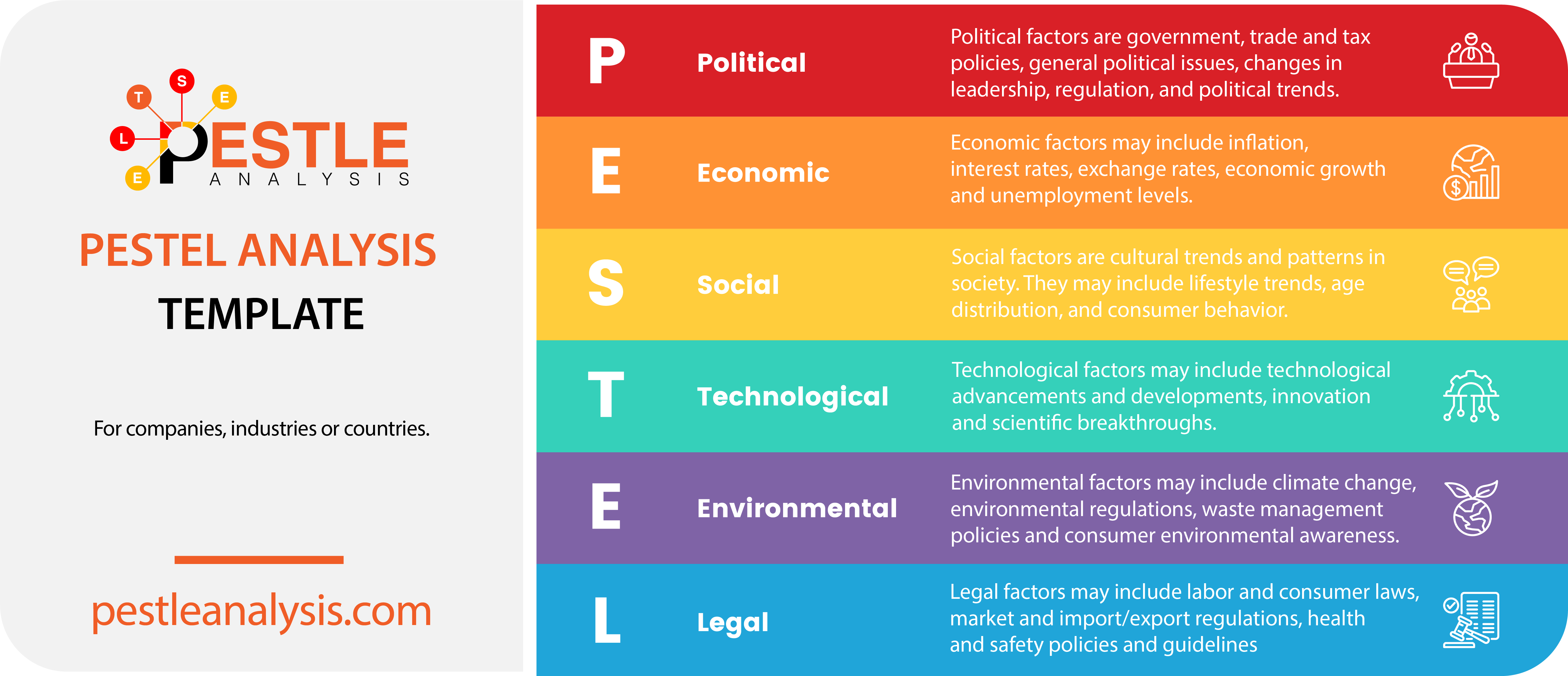A PESTLE analysis examines how Political, Economic, Social, Technological, Legal, and Environmental external factors affect a business or an organization.
Explaining PESTLE analysis is easy since it is a simple, straightforward analysis used in strategic planning. Below, we'll go through everything you need to know about the PESTLE tool with examples for easier comprehension.
Let's start by briefly explaining the PESTLE model of analysis with a clear PESTLE definition.
What is a PESTLE Analysis?
PESTLE analysis identifies and evaluates how Political, Economic, Social, Technological, Legal, and Environmental factors impact business operations. The strategic planning framework helps business and project managers in the decision-making process.
A PESTLE analysis helps them determine how these factors will affect a business's performance and strategy in the long term. It gives a bird's-eye view of the whole environment that business managers need to consider while contemplating a certain business idea or plan, based on the 6 elements of PESTLE analysis.
In short, that's what the PESTLE analysis acronym stands for: Political, Economic, Social, Technological, Legal, and Environmental.
But then, what is PESTEL Analysis?
A PESTEL analysis is essentially the same as a PESTLE analysis. The slight difference in naming (PESTLE vs. PESTEL) doesn’t reflect any difference in the analysis itself. It’s simply a matter of preference in the order of the letters. The fundamental purpose and methodology remain the same in both frameworks
What are the 6 PESTLE macroenvironmental factors in more detail?
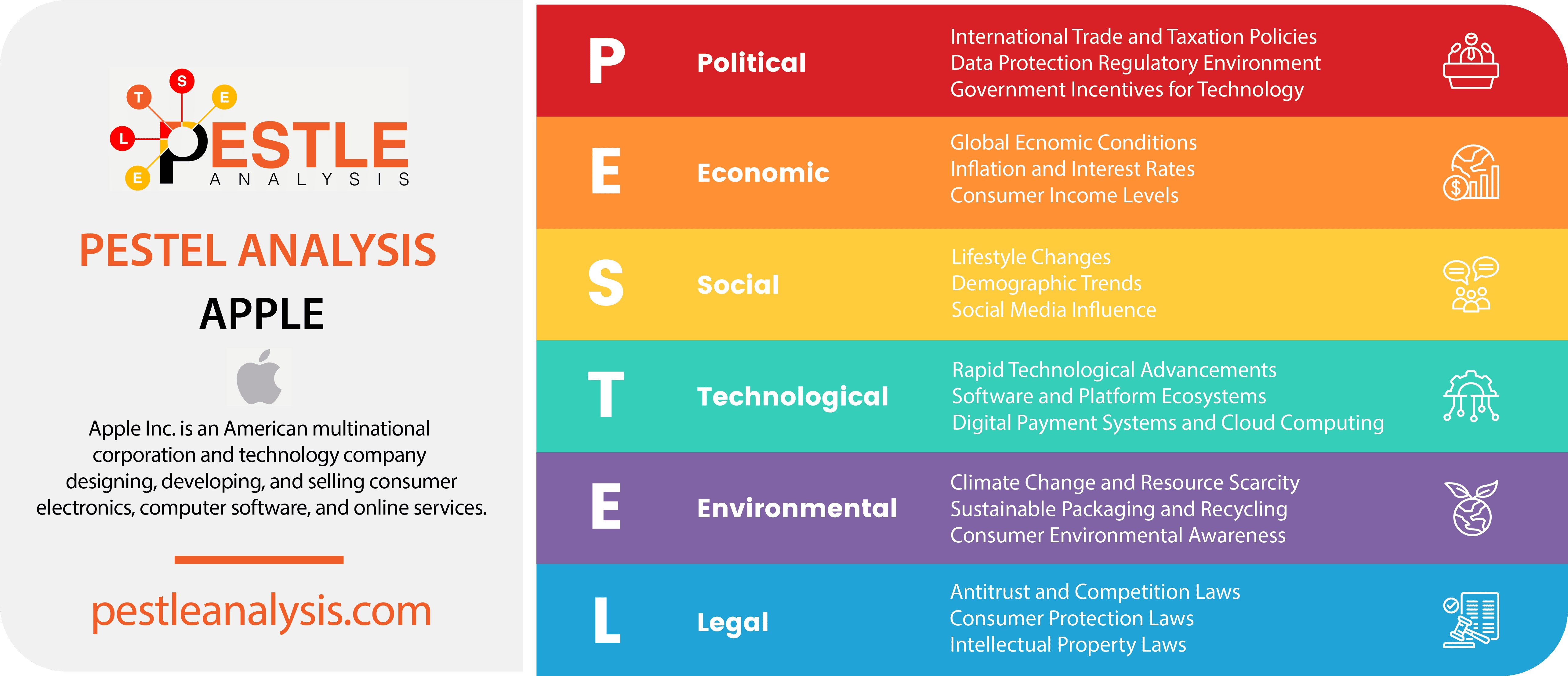
PESTLE analysis factors are Political, Economic, Social, Technological, Legal and Environmental. They are all external factors, meaning the organization or business has no control over them.
Political Factors
Political factors in PESTLE analysis are:
- government, trade and tax policies
- general political issues
- changes in leadership
- regulation and political trends
Economic Factors
Economic factors in PESTLE analysis are external factors that influence the economy’s performance, which in turn can affect businesses, industries and individuals. These factors include:
- Inflation
- Interest rates
- Exchange rates
- Economic growth
- Unemployment levels
Social Factors
Social factors in PESTLE analysis are social and cultural changes, new trends and patterns in society. These can be:
- Lifestyle trends
- Education level
- Age distribution
- General attitudes
- Consumer behavior
- Health consciousness
- Family and population size
Technological Factors
Technological factors in PESTLE analysis are external factors related to the existence, availability, and development of technology, automation, research and development, and the amount of technological awareness that a market possesses. Common factors in this section are:
- E-commerce
- Cybersecurity Threats
- Emerging Technologies
- Big data and computing
- AI and Machine Learning
- Supply Chain Automation
If we were to stop here, these factors would make for a PEST analysis, much like Francis J. Aguilar came up with inventing PEST! But let's continue.
Legal Factors
Legal factors in the PESTLE model are external factors that refer to how the law and regulations affect the way businesses operate. These may include:
- Labor laws
- Consumer laws
- Market regulation
- Health and safety laws
- Import/Export regulations
- Anti-competitive practices
Environmental Factors
Environmental factors in PESTLE analysis are external factors that describe how our planet and ecosystem can impact the organization, and some are:
- Sustainability
- Climate change
- Waste Management
- Environmental regulations
- Consumer Environmental Awareness
Note that each of the factors may have a different effect, depending on the business type. For example:
- the rise of e-commerce (Technological factor) has a positive impact on online shopping marketplaces, such as Amazon, eBay and Shopify. At the same time, it has negatively affected traditional retail stores, such as JCPenney and Sears.
- political support for renewable energy policies (Political factor) is an ally for companies that manufacture and sell electric vehicles, such as Tesla, but a challenging factor for businesses operating in the fossil fuel industry.
Learn more details of the external factors here.
How to do a PESTLE Analysis the Right Way?
Once they know the six factors that make the PESTLE model, business and project managers need to ask certain questions to reveal how external factors affect the organization, business, or project.
To know how to do PESTLE analysis, they need to ask:
- Political factors: What is the country's political situation, and how can it affect the industry and, subsequently, the business? Is the political environment changing, and what are the current trends under the specific administration?
- Economic factors: What does the economy look like currently? Is the economy growing or shrinking?
- Social factors: Are there any significant shifts in consumers' preferences and buying trends? What are the latest social patterns, and how have they influenced people's behavior?
- Technological factors: What are the latest technological advancements and breakthroughs?
- Legal factors: What kind of regulations and legislation are put into effect? Any key changes in the legal system and compliance policies?
- Environmental factors: What are the current environmental trends and policies?
It's up to the manager or analyst to figure out what information is relevant to the scope of their analysis. For example, it doesn't make sense to include every legal or environmental factor if those have no influence on the specific organization in question.
As long as the factors do affect the business, though, we don't just blindly list them in their relevant category. Usually, we start with the most impactful factor and move to less important ones for each category.
When we have listed all key factors that influence the business' operations, we can fill in the PESTLE analysis template.
They are better kept short and concise. Focus on relevant information and make sure the analysis leads to actionable recommendations and ideas.
What is a PESTLE Analysis used for, and why is it important?
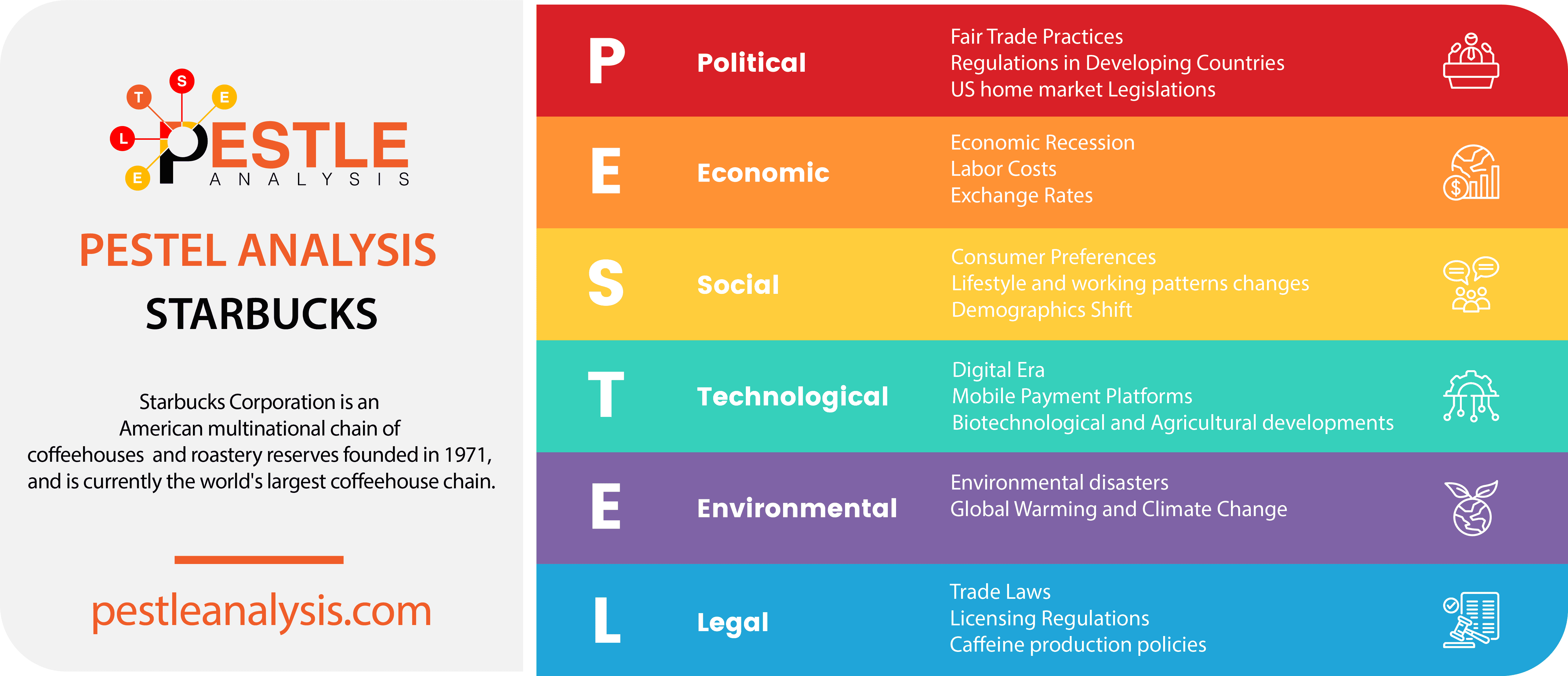
The aspects of this technique are crucial for any industry a business might be in.
More than just understanding the market, the PESTLE analysis framework represents one of the vertebrae of the backbone of strategic management, which not only defines what a company should do but also accounts for an organization’s goals and the strategies attached to them.
As we said, a PESTLE analysis is used to analyze the macro environment and assess its six external factors (Political, Economic, Social, Technological, Legal, Environmental). As a result, PESTLE analysis is used for capturing new opportunities and avoiding potential threats.
That's why PESTLE is usually accompanied by a SWOT analysis for a complete overview of the business.
Advantages of PESTLE Analysis
PESTLE analysis is:
- simple, easy, cost-effective and straightforward
- offers a deeper understanding of the business
- raises alertness
- showcases opportunities
- makes the business compliant
- helps in future strategic planning
Disadvantages of PESTLE Analysis
While being a powerful strategic planning tool, PESTLE Analysis:
- cannot offer the full picture
- is time-consuming
- is data-hungry
- needs regular updates
- risks mishandling information
- isn't necessarily the best tool because of its simplicity.
PESTLE Analysis Examples
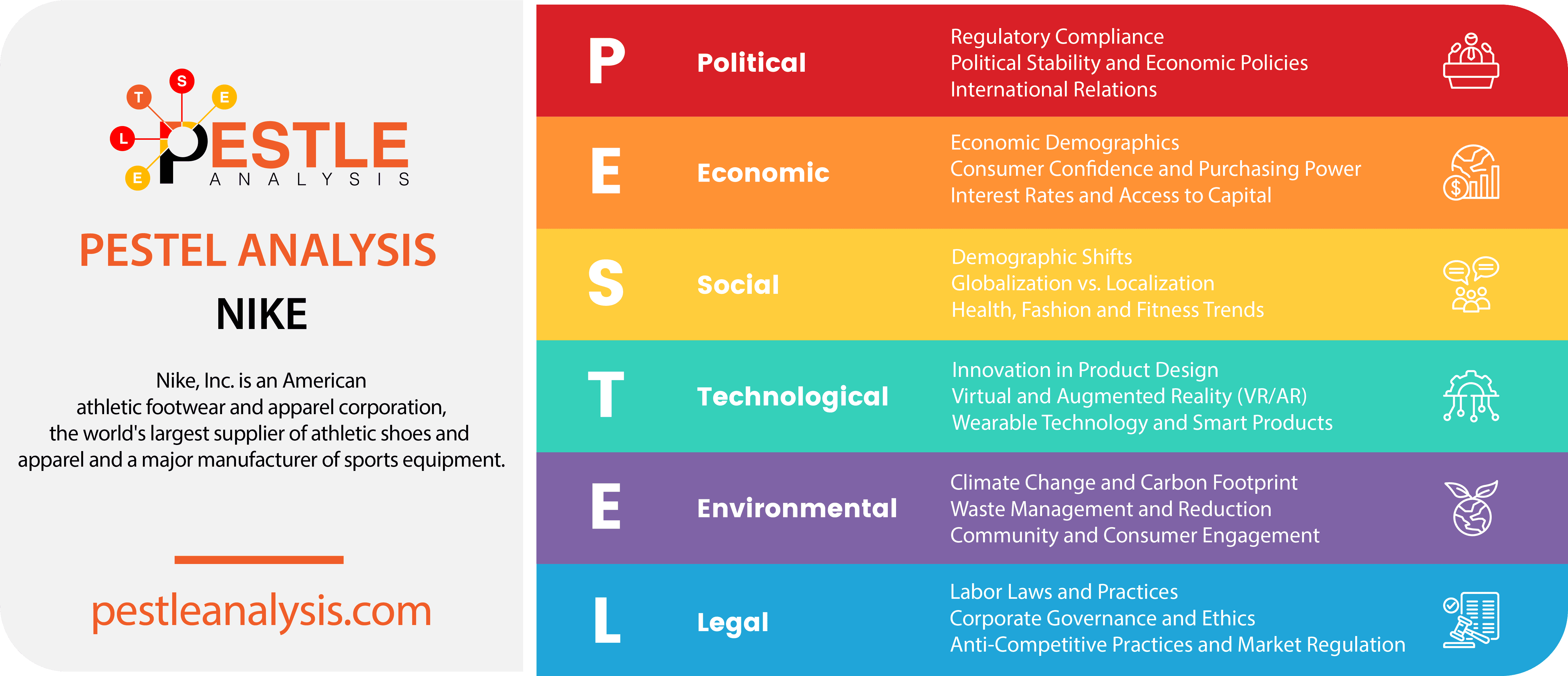
Here at PESTLEanalysis.com we have conducted a PESTLE analysis for various companies, industries and even countries! PESTLE analysis examples vary from startups to conglomerate corporations, from tiny to huge industries, from the smallest to the biggest countries in the world.
Let's see a few distinct examples of each very briefly, since you may check the full analysis in the corresponding article.
PESTLE Analysis Example of a Company
Let's first take a look at the external factors that affect Nike, the sportswear company, according to our PESTLE Analysis of Nike, to understand the PESTLE meaning in the business world:
- Political: As an American company, Nike is influenced by the political stability in the United States. Other political factors include regulatory compliance, global trade policies and tariffs, international relations and economic and environmental policies.
- Economic: Supply chain costs, market segmentation and economic demographics are huge economic factors for Nike, followed by trade agreements and global economic fluctuations.
- Social: Nike is affected by the latest health and fitness trends, digital and social media influence, demographic shifts and cultural and fashion trends.
- Technological: Innovation in product design and material are probably the biggest technological factor affecting Nike. Wearable technology, virtual and augmented reality also play a big part, as these technologies enhance the online shopping experience and drive engagement in retail spaces.
- Legal: Labor laws and practices, anti-competitive and market regulations are affecting Nike.
- Environmental: Waste reduction and recycling trends in the fashion industry are having an impact on Nike, making them introduce a recycling program. Other environmental factors include the introduction of eco-friendly materials and operation impact due to climate change.
PESTLE Analysis Example of an Industry
In our PESTLE analysis of the food industry, we examined the external factors below:
- Political: The food industry is affected by global regulatory frameworks imposed by governments to address health concerns. These health policies and food safety regulations lead the industry's companies to adapt their business plans and introduce new options in their menus. Meanwhile government bodies offer subsidies and support affecting the competitiveness within the industry, while environmental regulations towards sustainable farming influence the production practices. At the same time, taxes and trade agreements affect import/export and total costs.
- Economic: Consumer spending power and increasing labor costs are at the top of the economic factors affecting the food industry. Global commodity prices has a direct effect to the industry's growth, while inflation, supply chain costs and economic stability can have a big impact on the food industry's operations.
- Social: Social factors affecting the food industry include health and wellness trends, cultural diversity, demographic and lifestyle changes, social media influence and education level.
- Technological: The food industry is dependent on new food production and safety technologies, packaging innovations, automation and robotics, nutritional science advances and even data analytics, as they improve consumer behavior prediction and personalized marketing!
- Legal: Employment and animal welfare laws, health and food safety standards, labeling requirements and advertising regulations are all part of the legal factors that affect the food industry.
- Environmental: The food industry is hugely affected by climate change, water scarcity, energy consumption and waste management, along with consumer awareness and packaging materials.
PESTLE Analysis Example of a Country
According to our PESTLE Analysis of Japan, the country is affected by the following external factors:
- Political: Japan's growth depends on the winning party in the elections, despite being a monarchy, since the Emperor isn't very involved in politics. Given the Liberal Democratic Party (LDP) has dominated the elections since World War 2 for the most part, Japan isn't affected by regular leadership changes. Japan is also affected by its pacifist constitution that renounces the act of war. Also, following the nuclear disaster in Fukushima in 2011, Japan's shifting energy policy against nuclear sources, has affected its international environmental agreements.
- Economic: Japan's future is affected by its public debt, an export-driven economy and currency fluctuation.
- Social: The Asian country is strongly affected by its aging population, its unique work culture and lifestyle, its strong emphasis on education and technological literacy, along with challenges originating from the trend of urban living.
- Technological: Japan's focus on innovation and technology fuels its economic growth. Their emphasis on big data, robotics and promoting the concept of "Society 5.0" address societal hurdles and created a smart society. Japan's automotive sector is hugely affected by its smart transportation technologies, while the widespread access to high-speed internet helps businesses flourish in the digital era.
- Legal: As intellectual property rights, environmental regulations and data protection policies are becoming popular legal trends worldwide, Japan's legal system is bound to be affected as well. As the world shifts towards a stricter regulatory framework, Japan is posed to follow along.
- Environmental: The same can be said for the public's increasing environmental awareness. Worries about climate change, biodiversity, and conservation efforts, along with waste management and recycling policies, will influence how Japan moves into the greener future of our planet.
PESTLE Analysis Templates

Using a PESTLE analysis template in PDF, Word, or PowerPoint format offers significant benefits.
These formats provide flexibility and ease of use, allowing students, business managers, and owners to customize the analysis according to their needs. PDF ensures a professional, easily shareable document, while Word and PowerPoint formats allow for seamless editing and integration into reports and presentations. Additionally, exporting in various formats like JPEG, PNG, and SVG makes it easy to incorporate the analysis into different types of documents.
Check out our article on PESTLE analysis templates for more on creating your own template and where to find free ones.
PESTLE Analysis Variations
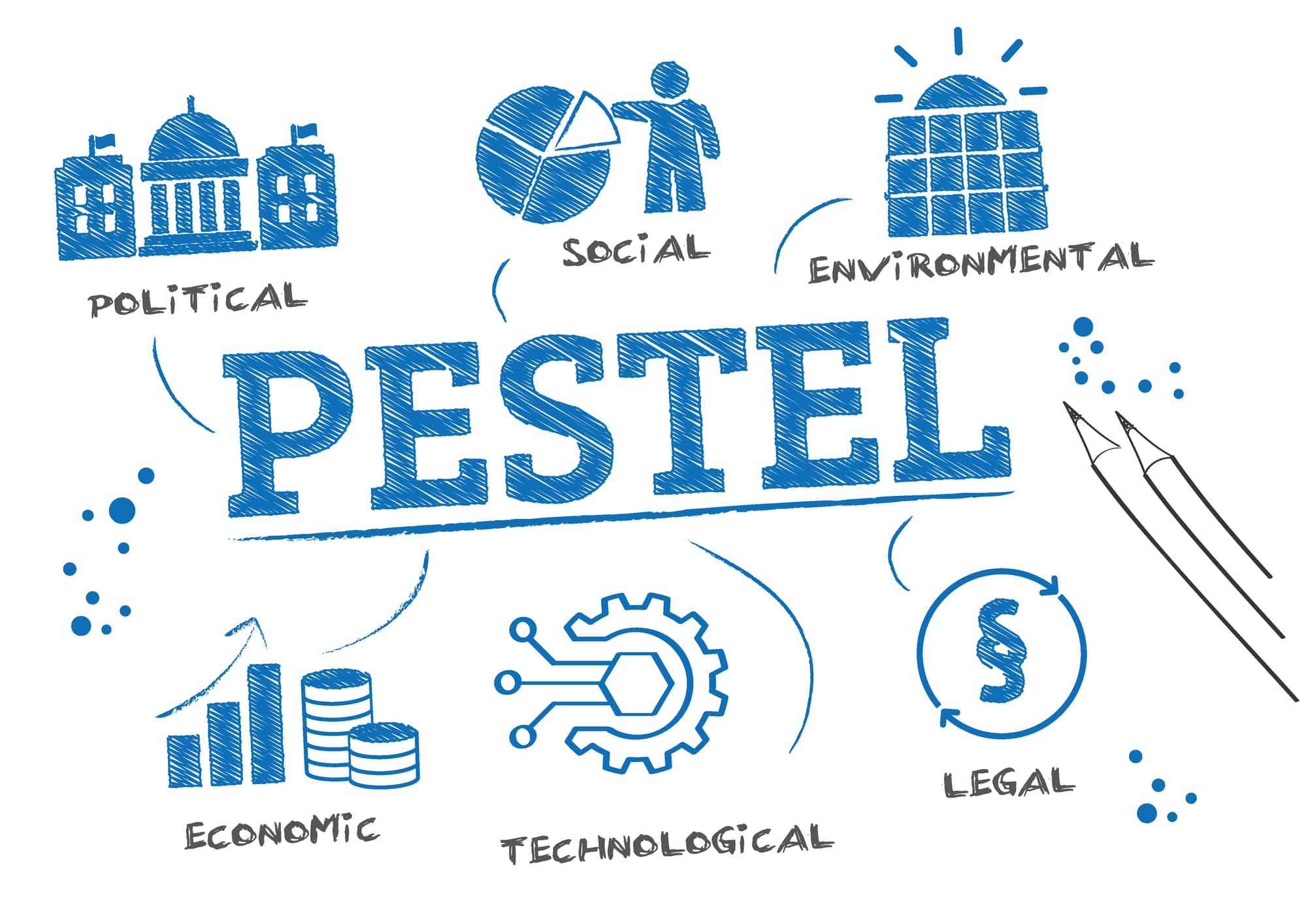
The PESTEL framework has undergone specific alterations. Business experts have added things like an E for Ethics in STEEPLE Analysis and a D for Demographics in STEEPLED analysis to instill the element of demographics while utilizing the framework in market research.
What is the difference between PESTLE and SWOT Analysis
SWOT Analysis is another popular tool to help in business and project management and is often mentioned along with PESTLE analysis. SWOT analysis reveals the Strengths, Weaknesses, Opportunities and Threats of an organization.
While both strategic planning tools offer valuable insights that are very important in the decision-making process, they view the world from a different perspective.
- PESTLE analysis focuses on external factors only. SWOT Analysis considers both internal and external factors.
- PESTLE analysis offers a broader view of the external environment, while SWOT links a business' internal potential with the external environment.
- SWOT analysis is used to formulate business strategies that leverage strengths and address weaknesses, which PESTLE analysis is totally ignorant of.
In a nutshell, PESTLE analysis explores the external terrain on which an organization operates, and SWOT analysis provides insights on how to respond on those external forces, based on the organization's unique strengths and weaknesses.

